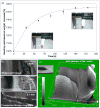Structural responses of DNA-DDAB films to varying hydration and temperature
- PMID: 20438082
- PMCID: PMC2895560
- DOI: 10.1021/ja909514j
Structural responses of DNA-DDAB films to varying hydration and temperature
Abstract
The structure of a DNA-dimethyldidodecylammonium bromide (DDAB) film was recently described to undergo a distinctive transition in response to the water content in the surrounding environment. The existence, preparation, and basic properties of DNA-surfactant films have been known in the literature for some time. Here, we describe the structural response of DNA-DDAB films to environmental changes, particularly temperature and humidity, in greater detail revealing new structural states. We can direct the lamellar structure of the film into three distinct states--double-stranded DNA (dsDNA) paired with an interdigitated bilayer of DDAB (bDDAB), single-stranded DNA (ssDNA) with monolayer of DDAB (mDDAB), and ssDNA with bDDAB. Both temperature and humidity cause the molecules composing the lamellar structure to change reversibly from ssDNA to dsDNA and/or from mDDAB to bDDAB. We found that the structural transition from dsDNA to ssDNA and bDDAB to mDDAB is concerted and follows apparent first-order kinetics. We also found that the double-stranded conformation of DNA in the film can be stabilized with the inclusion of cholesterol even while the DDAB in the film is able to form either a monolayer or bilayer depending on the environmental conditions. Films treated with ethidium bromide prompt switching of dsDNA to ssDNA before bDDAB transitions to mDDAB. Swelling experiments have determined that there is a direct proportionality between the macroscopic increase in volume and the nanoscopic increase in lamellar spacing when a film is allowed to swell in water. Finally, experiments with phosphate-buffered saline (PBS) indicate that the films can disassemble in a simulated biological environment due to screening of their charges by buffer salt. We conclude that the structure of DNA in the film depends on the water content (as measured by the relative humidity) and temperature of the environment, while the state of DDAB depends essentially only on the water content. The structure of the film is quite flexible and can be altered by changing environmental conditions as well as the chemical ingredients. These films will have useful, new applications as responsive materials, for example, in drug and gene delivery.
Figures







Similar articles
-
Reversible structural switching of a DNA-DDAB film.J Am Chem Soc. 2009 Mar 18;131(10):3440-1. doi: 10.1021/ja809349m. J Am Chem Soc. 2009. PMID: 19275252 Free PMC article.
-
Temperature-dependent structural changes on DDAB surfactant assemblies evidenced by energy dispersive X-ray diffraction and dynamic light scattering.Colloids Surf B Biointerfaces. 2012 Jun 15;95:170-7. doi: 10.1016/j.colsurfb.2012.02.037. Epub 2012 Mar 3. Colloids Surf B Biointerfaces. 2012. PMID: 22429784
-
A comparison of the higher order harmonic components derived from large-amplitude Fourier transformed ac voltammetry of myoglobin and heme in DDAB films at a pyrolytic graphite electrode.Langmuir. 2010 Apr 6;26(7):5243-53. doi: 10.1021/la903387n. Langmuir. 2010. PMID: 20232815
-
Electrochemical behavior of biocatalytical composite based on heme-proteins, didodecyldimethylammonium bromide and room-temperature ionic liquid.Anal Chim Acta. 2010 Mar 17;663(1):19-26. doi: 10.1016/j.aca.2010.01.015. Epub 2010 Jan 18. Anal Chim Acta. 2010. PMID: 20172091
-
Water-DNA interactions as studied by X-ray and neutron fibre diffraction.Philos Trans R Soc Lond B Biol Sci. 2004 Aug 29;359(1448):1237-47; discussion 1247-8. doi: 10.1098/rstb.2004.1501. Philos Trans R Soc Lond B Biol Sci. 2004. PMID: 15306379 Free PMC article. Review.
Cited by
-
Assembly of RNA nanostructures on supported lipid bilayers.Nanoscale. 2015 Jan 14;7(2):583-96. doi: 10.1039/c4nr05968a. Nanoscale. 2015. PMID: 25417592 Free PMC article.
-
Thermotropic liquid crystals from biomacromolecules.Proc Natl Acad Sci U S A. 2014 Dec 30;111(52):18596-600. doi: 10.1073/pnas.1421257111. Epub 2014 Dec 15. Proc Natl Acad Sci U S A. 2014. PMID: 25512508 Free PMC article.
-
Lipid-based Liquid Crystalline Films and Solutions for the Delivery of Cargo to Cells.Liq Cryst Rev. 2019;7(2):167-182. doi: 10.1080/21680396.2019.1666752. Epub 2019 Nov 4. Liq Cryst Rev. 2019. PMID: 31942262 Free PMC article.
-
Lipid-Nucleic Acid Complexes: Physicochemical Aspects and Prospects for Cancer Treatment.Molecules. 2020 Oct 28;25(21):5006. doi: 10.3390/molecules25215006. Molecules. 2020. PMID: 33126767 Free PMC article. Review.
-
Nanostructured Lipid-based Films for Substrate Mediated Applications in Biotechnology.Adv Funct Mater. 2018;28:10.1002/adfm.201704356. doi: 10.1002/adfm.201704356. Adv Funct Mater. 2018. PMID: 31080383 Free PMC article.
References
-
- Ijiro K, Okahata Y. J Chem Soc-Chem Commun. 1992:1339–1341.
-
- Hoshino Y, Tajima S, Nakayama H, Okahata Y. Macromol Rapid Commun. 2002;23:253–255.
-
- Radler JO, Koltover I, Salditt T, Safinya CR. Science. 1997;275:810–814. - PubMed
-
- Martin B, Aissaoui A, Sainlos M, Oudrhiri N, Hauchecorne M, Vigneron JP, Lehn JM, Lehn P. Gene Ther Mol Biol. 2003;7:273–289.
Publication types
MeSH terms
Substances
Grants and funding
LinkOut - more resources
Full Text Sources
Other Literature Sources

